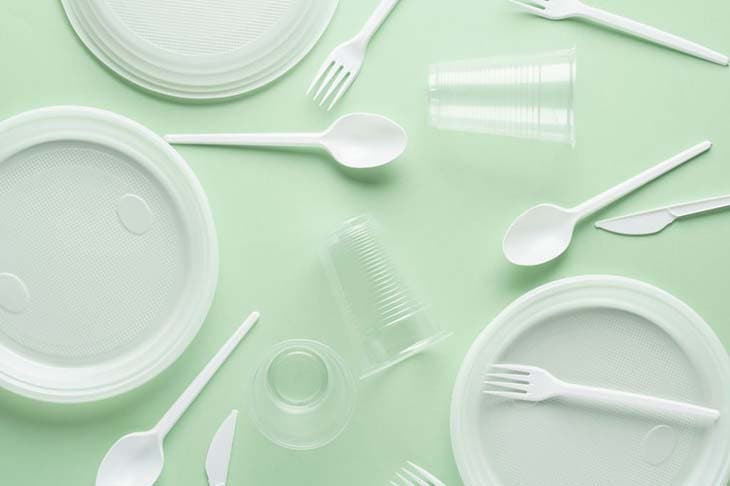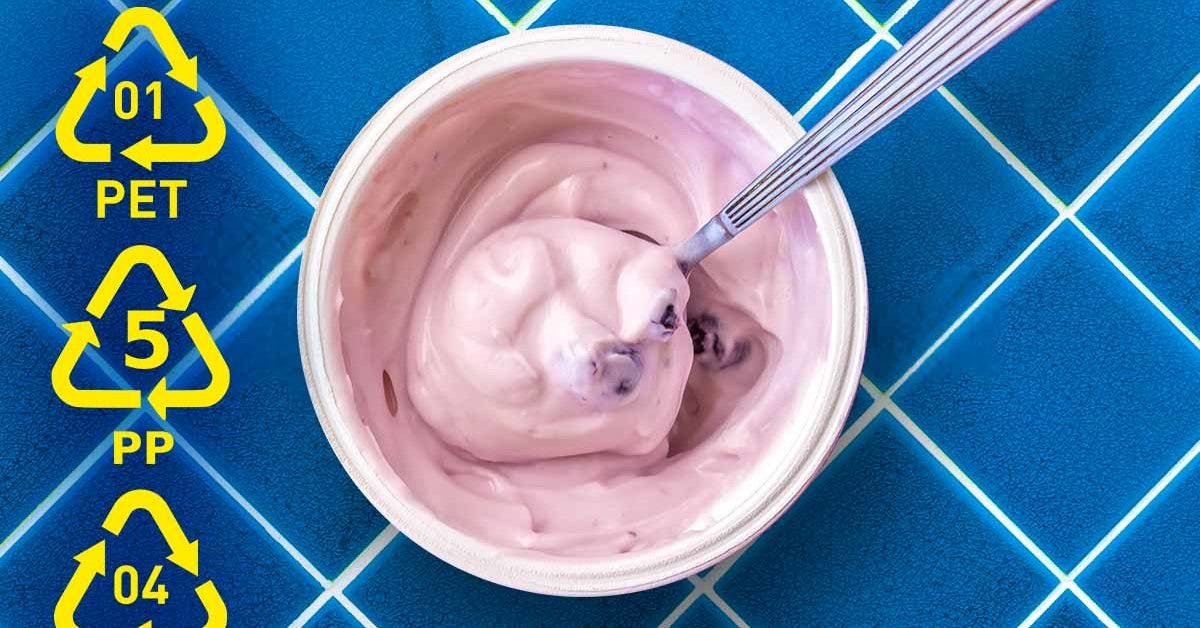Phthalates, bisphenol A…: how to prevent plastics from migrating onto your plate
After phthalates and bisphenol A, microplastics have just been discovered in human blood! That is to say that the widespread pollution caused by these residues from the oil industry is of concern today. In addition to their well-known effects on fertility, they are suspected of causing cancer. The first barrier measure for the consumer is to ban all contact with food plastics. How to get rid of them and what to replace them with? Our advice.
Many of us are wary of the components of plastics, recognized as endocrine disruptors, which can migrate into food. These petrochemical plasticizers interfere with the action of our hormones, causing reproductive disorders and sometimes cancer. This is why I have personally banned mineral water bottles, cling film, freezer bags, serving dishes and other practical plastic storage boxes.
I thought I was a good student in plastic avoidance. That was before talking to 2021 with the journalist Corinne Lalo, on the occasion of the release of her latest hard-hitting book, Le Grand Hormonal Disorder. Focused on the local, organic or artisanal aspect, I still had in my fridge local products packaged “vacuumed” with plastic: confit duck legs, duck breasts, pâtés… “Better to favor what comes in a terrine or cutting, especially for fatty products which particularly attract the fat-soluble components of plastics”, indicates Corinne Lalo.
Corinne Lalo recalls the danger of cooking with utensils or containers plastic (silicone pie dish, spatulas). “We sometimes see great chefs on television swaddling their preparations in plastic wrap before cooking. »

Plastic tableware – spm
Packaging and utensils to avoid as much as possible
To do well, it would ideally be necessary to ban almost everything:
- Yoghurt pots, milk and oil bottles, squeeze bottles
Complete the list! The common point is still and always plastic.
The danger of endocrine disruptors
The investigative journalist has had time to form an opinion on the formidable toxicity of endocrine disruptors released by plastics, not just food. The 486 pages of the Great Disorder hormones, documented by scientific studies, have revived my vigilance!
According to Corinne Lalo, endocrine disruptors are not only reprotoxic, that is to say they can alter the fertility of the man as of the woman and of the unborn child. They are also THE thread running through almost all of our civilizational diseases: by disrupting the hormonal system, they can cause diabetes, obesity, thyroid disease, leukemia, asthma, allergies, behavioral and brain development disorders… and even, according to her, sexual orientation disorders.
The large family of endocrine disruptors is made up of six pollutants (the “6 Ps”) : Pesticides (phytosanitary products), Plasticizers, Pharmaceuticals (drugs and food additives), Perfiuorides (Teflon, paper and cardboard packaging for food contact), Parabens and Polybrominated.
Among these “6 Ps”, pesticides and plasticizers are the most incriminated in what has been called “the sperm crash”, according to the shocking title of the book by doctor Pierre
Dutertre and scientific journalist Gérald Messadié, who studies the causes of the free fall in the number of e spermatozoa in a majority of men.
The two main plasticizers especially considered dangerous for men’s sperm health are again bisphenol A (BPA) and phthalates, components major plastics: BPA is present in hard plastics and phthalates are present in soft plastics.
Some plastics less toxic?
The migration of problematic substances may depend on use. The plastic glass of fruit juice will a priori be less toxic than the cup of hot coffee taken from the cafeteria. The heat, the contact time and the type of cooking can aggravate the process of contamination with food (red card in microwave D). The nature of the food also plays a role: the fattier the product, the more toxic particles it attracts (oil, cheese, ready meals).
Manufacturers spare no effort to stabilize the packaging material and have to deal with complex legislation. There are different codes for plastics, visible on the packaging. There are sites on the Internet that help you tell the difference between plastics with high migration and those that are considered more “stable”.
On paper, it seems clear . But the reality on the shelves is more opaque: for example, my pot of organic Casino yogurt does not mention any code, but simply indicates “plastic pot to throw away”. The meal bag for my cat indicates the code 90 (C/PP) and I couldn’t find anything about it on the web… Probably PP (5) mixed with something else. It is in any case “to throw away”. In short, a lot of information not very understandable by the general public.
In addition, no one is immune to the misuse of these containers.
For example, PET is the only plastic that can be microwaved “safely” (at least officially). All the others are either discouraged for this use (2.5, 6) or to be banned absolutely (3.4). If the PET withstands a maximum temperature of 100°C. The others oscillate between 60 and 75 °C.
“Distinguishing between all the plastics we are confronted with on a daily basis is a headache for the consumer.
In the end, it is still plastic and this material will always end up degrading and releasing endocrine disruptors on our plate or on the planet. For my part, I rather recommend having the broadest possible exclusion approach”, Corinne Lalo slices.
This is all the more relevant since toxicological research is still lagging behind in the commercialization of petrochemical molecules. If Bisphenol A is now banned from all food containers (such as baby bottles) because of its reprotoxic and carcinogenic effects, various manufacturers have replaced it with other products, such as Bisphenol B or Bisphenol S. They sometimes praise the absence of bisphenol A without specifying its replacement… potentially more harmful. Note that for tins and cans, bisphenol A is still authorized in the European Union.

Plastic container – spm
Until 60 particles of microplastics ingested per year
Plastic recycling is possible, but according to a WWF report of 2017, alone 60 % of plastic waste is recycled in France, and the country contributes to the rejection of 80 10 tons of plastic in the nature every year! Are microplastics now contaminating the entire planet, from the summit of Everest to the deepest oceans? Residues and microplastics are then absorbed by fish, animals in general, and of course, humans…
A study by 2017 had shown that Americans ingested up to 60 000 microplastic particles per year! People who meet the recommended water intake, only via a bottled supply, can ingest 20730 additional microplastics per year…
Another study published very recently, at the end of March 2020, has even just shown the presence of these residues in human blood. The scientists analyzed samples of 10 anonymous donors, all healthy adults, and found plastic particles in 17 voluntary donors, i.e. 90 % . Half of the samples contained PET plastic, a third contained polystyrene. A quarter of the blood samples contained polyethylene, from which plastic bags are made.
Previous work had shown that microplastics were 10 times more numerous in the faeces of babies than in adults and that babies fed with plastic bottles swallow millions of microplastic particles per day. Corinne Lalo mentions a study by 2017 on autistic children : they display a level of bisphenol A significantly higher than that of healthy children, and at the same time present fewer sex hormones in the blood. As you will have understood, it is urgent to act individually to protect future generations!
Among the good alternatives
- Use utensils or containers made of glass, ceramic, wood or stainless steel and enamelled cast iron.
Use filters in paper, stainless steel or fabric for coffee and infusions.
For disposable tableware, there are plates and cutlery made of 90 % vegetal and compostable (palm tree).
False alternatives, to be avoided
- Bamboo tableware: it contains melamine resin and formaldehyde, suspected of migrating into food. It is therefore a false material.
Labels are emerging: “OK Compost Home” (household compost) is thus to be preferred to “OK Compost” (industrial compost) to OK Biodegradable to (soil, water or marine environment) guarantees the compatibility of a bioplastic with a certain type of environment.
- Paper and aluminum trays: small particles can be transferred towards food, especially when the aluminum is exposed to heat (heating in the oven); in the event of an acid pH (tomato sauce)
The different “plastic codes”
An impact on our sexual orientation and identity?
Contamination in utero by endocrine disruptors, and in particular plastics, can it have an influence on our future sexual behavior? This is what several studies documented by Corinne Lalo suggest. Many researchers evoke the neuro-hormonal track in the genesis of our sexuality: the differentiation of the organs (first trimester of pregnancy) is indeed followed by a sexual differentiation of the brain, also dependent on hormones (second half of pregnancy). This second differentiation could influence our sexual orientation, beyond the physical characteristics. A chemical disturbance exerted by a pollutant could therefore on the one hand modify the embryogenesis of the organs (until ‘to intersex), and on the other hand lead to changes in identity or sexual orientation. “If the debate entered the public square, it is because the ambiguities of the genitalia at birth have multiplied, explains Corinne Lalo. The idea that sexual or gender orientation can be influenced by exposure to environmental toxins is still a sensitive subject, not to say taboo. Just as it is abusive to qualify intersexuality or homosexuality as a mental disorder, the biological explanation of sexual behavior cannot justify any stigmatization. On the contrary, it must facilitate the acceptance of differences and the fight against discrimination. “ The phenomenon of homosexuality and transsexualism has been observed in the children of mothers who have been exposed to endocrine disruptors of drug origin (distilbene, synthetic hormones of thyroid, antiepileptics, amphetamine appetite suppressants Mediator and Isomeride). In animals the phenomenon of modification of sexual behavior has been documented with several hormone-toxic pollutants: mercury, PCB, DDT (insecticides) but also phthalates and bisphenol A. These changes could be explained by disturbances in the activity of the hypothalamus, in particular at the level of the “preoptic nucleus”. In the event of contamination, the sex hormone receptors would be under-expressed there. Read also Do not put your feet on the dashboard. The consequences can be dramatic




